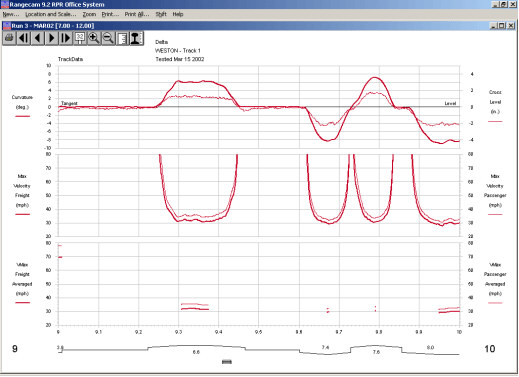
If your database contains curvature and crosslevel, Maximum Velocity Freight and Passenger can be automatically calculated for each geometry record, with the results being available in Track Condition charts. Since these values are calculated on the fly, they do not require any disk storage space. The formula used is:
Vmax = SQRT((Ea + Eu) / Cc D)
where:
Ea - actual superelevation of the outside rail, in inches
Eu - unbalance elevation (by default, 3" for freight, 4" for passenger)
Cc - curvature coefficient (by default, 0.0007)
D - curvature in degrees
US FRA standards specify that the superelevation and curvature values used in the formula be averaged for each 155-foot segment within the curve body (FRA Track Safety Standards, Part 213, § 213.329). For closer conformity with this standard, Rangecam includes the Calculate VMax (Averaged) feature. Since values based on averaging cannot reasonably be calculated on the fly, they are pre-calculated and stored, which does require additional database space.
The default values for unbalance elevation and the curvature coefficient are also from FRA standards. These values, which are stored in the database, may be changed to meet special customer requirements such as non-standard gauge. They are changed using the Rangecam Office System's Subdivision Table Maintenance dialog. These settings affect all VMax calculations in Rangecam: on-the-fly, averaged, and by track segment.
To run the VMax (Averaged) calculation, choose Run/Geometry/Calculate VMax (Averaged)... or for multiple runs, use Run/Calculate All... A dialog allows you to select a run, and a mileage range within the run. The Options button brings up a second dialog with calculation options.

You can choose to calculate VMax for Freight, Passenger or both. The segment length used for averaging is specified here. You can also choose to calculate VMax for the entire curve, or restrict it to the curve body.

VMax averaged over 155' (lower chart) compared to VMax calculated foot-by-foot (center)
If 'body only' is selected, the VMax (Averaged) channel displayed on charts will be very short for curves that are almost all spiral.